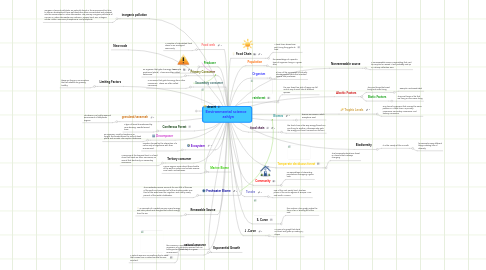Environmental science ashlyn
by ashlyn steltz


1. desert
1.1. Snakes
1.2. lizards
1.3. rabbits
1.4. very hottt!!!
2. Ecosystem
2.1. a system formed by the interaction of a community of organisms with their environment.
3. Coniferous Forest
3.1. a type of forest characterized by cone-bearing, needle-leaved trees
4. Freshwater Biome
4.1. The Freshwater Biome accounts for one fifth of the area of the Earth and provides half of the drinking water, one third of the water used for irrigation, and nearly ninety percent of the world's bathwater.
5. Marine Biome
5.1. Marine regions cover about three-fourths of the Earth's surface and include oceans, coral reefs, and estuaries.
6. grassland/savannah
6.1. This biome is a highly seasonal environment of temperate regions.
7. Food web
7.1. A complex of interrelated food chains in an ecological community
8. Producer
8.1. Example
9. Primary Consumer
9.1. an organism that gets its energy from producers (plants). These are often called herbivores.
10. Secondary consumer
10.1. a consumer that gets its energy from other consumers. These are often called carnivores.
11. Tertiary consumer
11.1. a carnivore at the topmost level in a food chain that feeds on other carnivores; an animal that feeds only on secondary consumers.
12. Decomposer
12.1. an organism, usually a bacterium or fungus, that breaks down the cells of dead plants and animals into simpler substances.
13. Exponential Growth
13.1. the maximum, equilibrium number of organisms of a particular species that can be supported indefinitely in a given environment.
14. Limiting Factors
14.1. these are things in an ecosytem that tell whether its growing healthy
15. Renewable Source
15.1. an example of a renable source is iwnd energy and solar panels and shingles that collect energy from the sun
16. natural resource
16.1. a natural resource is something that is used that comes from a natrual source like usn, wind,ect.
17. inorganic pollution
17.1. Inorganic chemical pollutants are naturally found in the environment but due to human development these pollutants are often concentrated and released into the environment in urban stormwater. The primary inorganic pollutants of concern in urban stormwater are cadmium, copper, lead, zinc, nitrogen, nitrate, nitrite, ammonia, phosphorous, and phosphate.
18. New node
19. Biomes
19.1. biomes are areas in which ecosytems exist
20. rainforest
20.1. the rain forest has alot of heavy rain fall and its very humid. lots of different species.
21. food chain
21.1. the food chain is the way energy flows from one thing to another; otherwise who gets the energy and how it comes from the sun
22. Organism
22.1. a form of life composed of mutually interdependent parts that maintain various vital processes
23. Population
23.1. the assemblage of a specific type of organism living in a given area.
24. Community
24.1. an assemblage of interacting populations occupying a given area
25. Temperate deciduous forest
25.1. The temperate deciduous forest is a biome that is always changing.
26. Tundra
26.1. one of the vast, nearly level, treeless plains of the arctic regions of Europe, Asia, and North America
27. Food Chain
27.1. A food chain shows how each living thing gets its food
28. Aboitic Factors
28.1. They are things that arent living and never living
28.1.1. Example: Rock,sand,steel
28.2. Biotic Factors
28.2.1. They are things in life that are living or once were living
29. Trophic Levels
29.1. any class of organisms that occupy the same position in a food chain, as primary consumers, secondary consumers, and tertiary consumers.
30. Biodiversity
30.1. it is the variety of life on earth
30.1.1. for example many different things creating lots of diversity
